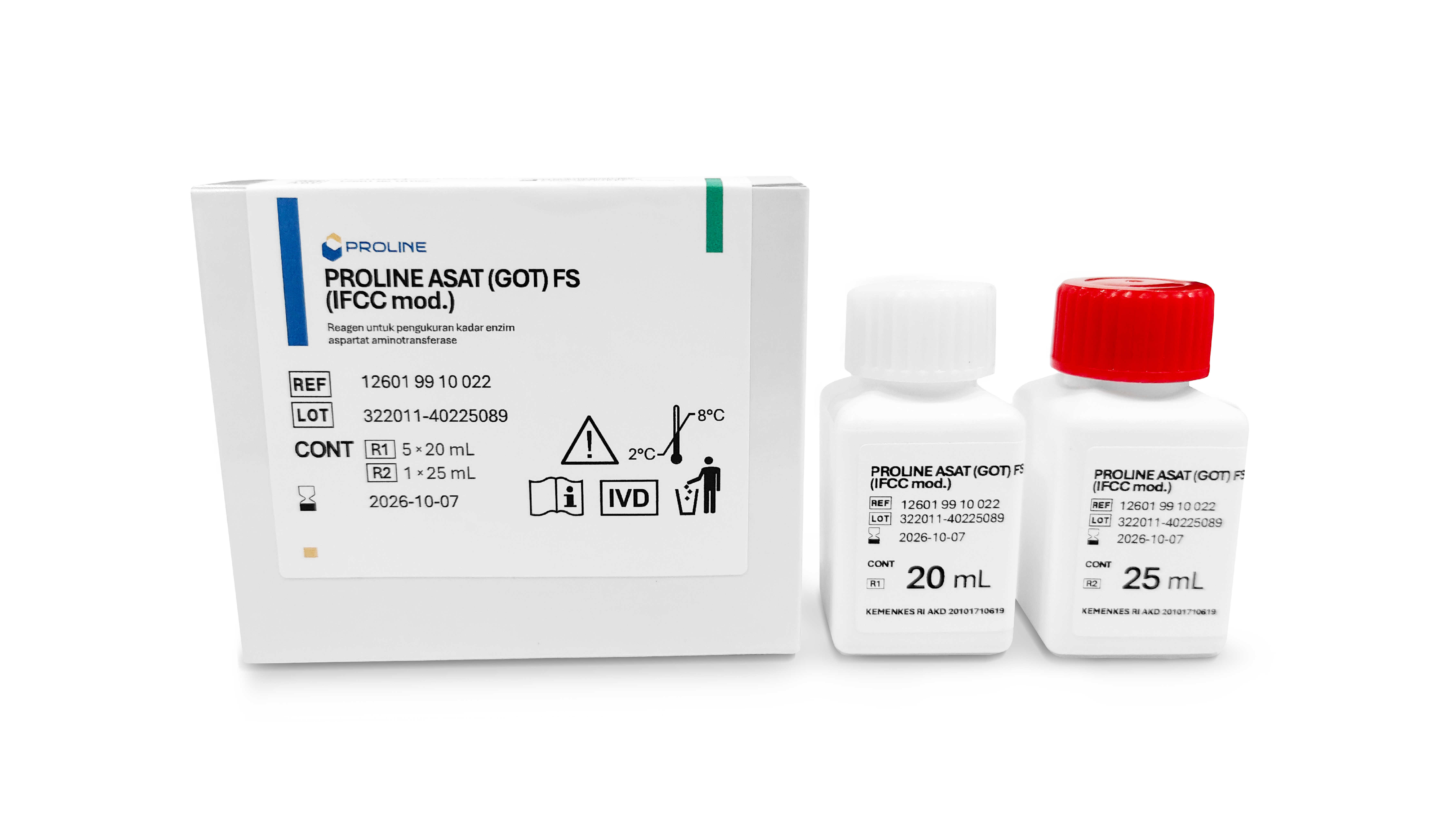PROLINE ASAT (GOT) FS (IFCC mod.)

| Catalogue Number | R1 Reagent Volume | R2 Reagent Volume |
| 12601 99 10 920 | 4 x 34 mL | 4 x 10 mL |
| 12601 99 10 921 | 4 x 21 mL | 4 x 6 mL |
| 12601 99 10 191 | 4 x 36 mL | 4 x 9 mL |
| 12601 99 10 181 | 4 x 36 mL | 4 x 9 mL |
| 12601 99 10 022 | 5 x 20 mL | 1 x 25 mL |
| 12601 99 10 025 | 3 x 80 mL | 1 x 60 mL |
| 12601 99 10 029 | 3 x 200 mL | 1 x 150 mL |
| 12601 99 10 965 | 6 x 25 mL | 6 x 6 mL |
| 12601 99 10 914 | 6 x 60 mL | 6 x 15 mL |
| 12601 99 10 951 | 6 x 36 mL | 6 x 9 mL |
| 12601 99 10 591 | 4 x 60 mL | 4 x 15 mL |
| 12601 99 10 027 | 2 x 100 mL | 2 x 25 mL |
Diagnostic reagent for the in vitro quantitative determination of ASAT (GOT) in serum or heparin plasma using a photometric system.
Aspartate Aminotransferase (ASAT/AST), previously known as Glutamic Oxalacetic Transaminase (GOT), is one of the most important enzymes in the aminotransferase or transaminase group. It catalyzes the conversion of α-keto acids into amino acids through the transfer of an amino group. Elevated levels of ASAT can also occur due to damage to the heart muscle, skeletal muscles, or liver parenchyma. Parallel measurement of Alanine Aminotransferase (ALAT) and ASAT is commonly performed to distinguish liver damage from damage to the heart or skeletal muscles.
Increased levels of ASAT in the blood can occur due to damage to the heart muscle, such as in a heart attack (myocardial infarction) or damage to skeletal muscles caused by trauma, excessive physical activity, or conditions like rhabdomyolysis. ASAT is released into the bloodstream when muscle tissue is damaged. However, since ASAT is not specific to the heart or skeletal muscles, additional analyses such as measuring Alanine Aminotransferase (ALAT) or other biomarkers like creatine kinase (CK) or Troponin, are needed to more accurately determine the source of the damage.
The optimized UV test according to the IFCC (International Federation of Clinical Chemistry and Laboratory Medicine).
- Ready-to-use liquid reagent (open-system) without reconstitution
- Excellent linearity and stability performance
- Available in MPK (Multi-Purpose Kit) and dedicated kit
- Compatible with >65 brands of manual and automated clinical chemistry analyzers
| Sample type | Human heparin serum or plasma |
| Measurement range | 2 U/L - 675 U/L |
| Analysis wavelength | 340 nm, Hg 334 nm, Hg 365 nm |
| Analysis mode | Kinetics |
| Reagent volume used (analyzer manual) | R1: 1000 µL ; R2: 250 µL |
| Sample volume used (analyzer manual) | 100 µL |
| Storage temperature | 2 – 8 °C |
| Open vial stability | 12 months |
| Expiration date | 15 months |
| Reference Range: | ||
| U/L | μkat/L | |
| With P-5-P | ||
| Woman | < 31 | < 0.52 |
| Man | < 35 | < 0.58 |
| 1 - 3 years | < 50 | < 0.83 |
| 4 - 6 years | < 45 | < 0.75 |
| 7 - 9 years | < 40 | < 0.67 |
| 10 - 12 years | < 40 | < 0.67 |
| 13 - 15 years | < 35 | < 0.58 |
| 16 - 18 years | < 35 | < 0.58 |
| Without P-5-P | ||
| Woman | < 31 | < 0.52 |
| Man | < 35 | < 0.58 |
- Aspartate Aminotransferase (ASAT/GOT) Reagent
- Doos
- Kit insert
- Reagents bottle
- Kit Insert PROLINE ASAT (GOT) FS (IFCC mod.) Ed. 01 - 12601 01 – Sep 2024/01
- Ndrepepa, G. (2020). Aspartate aminotransferase and cardiovascular disease—a narrative review. Journal Of Laboratory And Precision Medicine, 6. doi:10.21037/jlpm-20-93.
- Brochure : INA
- Liver Disease
Contact our team to find out more product information and ordering
- Telp : +62 21 8984 2722
- WhatsApp : +62 815 1359 2626
- Email : marketing@proline.co.id
Contact our Technical support team for further assistance with product specifications, services and other technical documents.
- Telp : +62-21-8984-2722
- WhatsApp : +62-817-9324-884
- Email : technical.support@prodis.co.id
